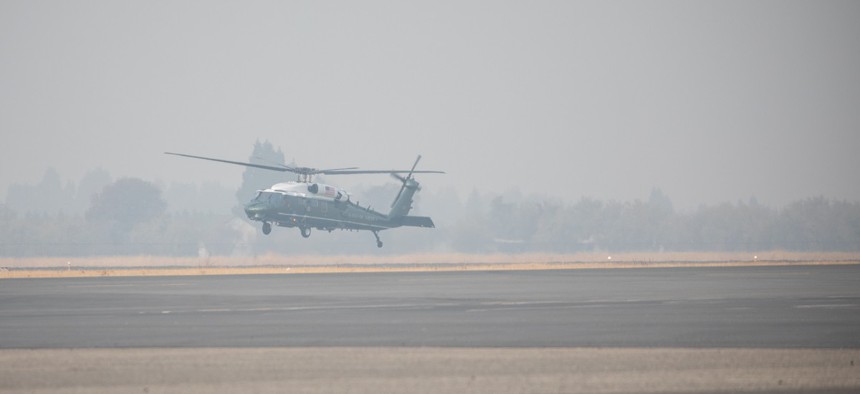
Marine One with President Donald J. Trump aboard departs in a smoky haze from Beale Air Force Base, Calif. after the wildfires in November. Shealah Craighead/White House
The Air Really Was Cleaner Under Obama
Pollution is up nearly 14 percent under the Trump administration.
Perhaps the most remarkable aspect of President Donald Trump’s speech on Monday was that it happened at all.
It was billed as a celebration of Trump’s environmental leadership. Three senators and six Cabinet-level leaders—powerful people whose scarcest resource is their time—watched the president speak for close to an hour. During that period, Trump did not announce a new green program, nor did he reverse any of his 83 environmental rollbacks. He alluded to the climate only once, when he criticized the Paris Agreement, and he never actually said the phrase climate change, nor did he acknowledge that Earth is warming.
Axios reported that the White House was previewing Trump’s reelection message, that it sought to portray him “as pragmatic … to appeal to suburban women.” According to a Washington Post/ABC News poll released this past weekend—a poll that found Trump’s approval rating at 44 percent, one of its highest readings ever—the public overwhelmingly disapproves of the president’s climate policy. Sixty-two percent of Americans dislike Trump’s climate record, a worse reading than he earns on immigration, gun violence, or health care.
So Monday, we learned what a slightly greener Trump looks like.
The president, hard up for actual environmental accomplishments, kept rounding back to the EPA’s success in delisting Superfund sites. It’s true that the EPA has finished cleaning up 22 heavily toxic places under Trump, but many of the sites were the subject of a years-long effort that preceded his administration.
Trump then talked up alternative energy. “I’m a big believer in solar energy,” he said. That makes sense as a pitch: Solar energy is overwhelmingly popularamong Americans of all parties. But he is doing very little to help its cause. The solar-power industry has lost roughly 18,000 jobs under the Trump administration, according to its trade group. The group says that most of that hemorrhage is due to the president’s tariffs. (The coal industry has gained 2,000 jobs in the same time.) Trump also didn’t mention wind energy during his speech. It’s just as popular as solar energy, but in April the president alleged it causes cancer. (It doesn’t.)
Most important, Trump brought back a promise from his 2016 campaign. “From day one, my administration has made it a top priority to ensure that America has among the very cleanest air and cleanest water on the planet,” he said. And maybe if administration officials still phrased this as an aspiration, it would be true: Trump wants the U.S. to have the cleanest air! He’s not helping matters much at all, but hey, at least he wants it!
Except Monday the White House went further. “Today we have the cleanest air on record,” said Andrew Wheeler, the administrator of the U.S. Environmental Protection Agency, during the event. “Pollution is on the decline, and our focus is to accelerate its decline, particularly in the most at-risk communities.”
“Under your administration,” he added, addressing Trump, “emissions of all the criteria air pollutants have continued to decline.”
The problem is that neither of those claims is true. Six types of dangerous air pollutants qualify as “criteria” pollutants under the Clean Air Act, and all are toxic in some form to human health. At least three of them—ozone, nitrous oxide, and particulate matter—are more prevalent now than they were in 2016, before Trump took office, according to EPA data released this week.
The number of “unhealthy-air days” across the country is also increasing. An unhealthy-air day is a day when ozone or particulate matter poses a threat to at least some of the population, such as children, the elderly, or people with lung conditions. Particulate matter is one of the deadliest environmental toxins, and it still kills tens of thousands of Americans every year. Across 35 major American cities, there were nearly 14 percent more of these days in 2018 (799) than in 2016 (702), according to the EPA. The record for the fewest-ever number of unhealthy-air days was set in 2014, during the Obama administration, when there were only 598.
And Wheeler’s broader claim that “pollution is on the decline” is also untrue. American emissions of carbon-dioxide pollution surged last year, after several years of decline. Carbon dioxide traps heat in the atmosphere and acidifies the ocean, and it is the most significant driver of climate change.
Neither Trump nor Wheeler is doing anything to help this situation. The EPA is pulling back on its regulation of coal plants, and it’s changing how much it weighs the public-health risks of some toxic air pollution. In addition to rolling back some rules, it has substantially reduced its enforcement and prosecutionof existing ones. It is trying to freeze fuel-economy rules for new cars, which will increase highway pollution. And it is doing almost nothing about climate change. On top of all this, a number of factors in the economy are encouraging more pollution right now: Flights are cheap, gas prices are low, and some recent winters have been cold enough to spike heating-oil use.
Trump’s boast that the United States has “the cleanest water” actually holds slightly more, uh, water. According to the 2018 Yale Environmental Performance Index, the United States is tied with nine other countries at No. 1 for meeting the highest drinking-water standards.
But the same report ranked the United States 31st for sanitation and 39th for wastewater treatment worldwide, and 27th for overall environmental performance. “This ranking puts the United States near the back of the industrialized nations,” the report warns, “behind the United Kingdom (6th), Germany (13th), Italy (16th), Japan (20th), Australia (21st) and Canada (25th).”







